| CHEVROLET CORVETTE History
Introduction: The
Chevrolet Corvette first appeared in 1953 as a unique American entry into
the sports car market dominated by European makes. Although not a muscle
car by definition, the Corvette used muscle car powertrains and has represented
American performance for almost fifty years.
1953 Chevrolet
Corvette
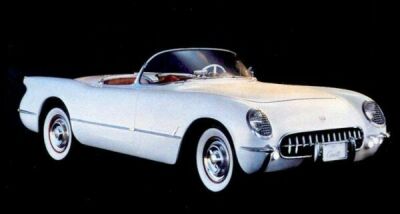 Comments:
The first Corvette rolled off a makeshift assembly line in Flint Michigan
on June 30, 1953, a mere six months after the debut of the concept car
at the GM Motorama. From the beginning, the Corvette was unique. It was
only available as a two passenger convertible in Polo White with a red
interior. All Corvettes were built by hand and its attractive and original
body was constructed out of fiberglass, not steel. Its chassis, with a
102 inch wheelbase, was basically a shortened Chevy passenger car unit.
The only engine available was named the Blue Flame Special and was an upgraded
version of the 235 cid six found in other Chevy cars. It produced 150 bhp
due to the use of a higher lift cam which provided a significant boost
in torque in the mid-range of engine speed. The valves were special alloy
steel and fitted with double springs. The engine also featured a 8.0:1
compression ratio and triple Carter downdraft carburetors on a cast aluminum
intake manifold. A dual exhaust was installed. The only transmission was
Chevrolet's Powerglide two-speed automatic. Although the powertrain was
a departure from typical American straight-line performance, coupled with
its light weight, the Corvette boasted excellent handling and road feel.
The Corvette's front suspension of coil springs and wishbones, used slightly
altered springs enclosing one inch diameter tubular shock absorbers. The
Corvette also had a large diameter anti-rool bar and at the rear, had four-leaf
semi-elliptical springs which were inclined front to rear to approvide
approximately 15 percent roll understeer. Only two Regular Production Options
(RPOs) were available, a heater and an AM radio. Exterior styling was done
by Harley Earl and featured a toothy grille, stone guards over the inseft
headlamps, "twin pod" rear fenders, and "rocket ship" taillights. The first
Corvette was a sales disaster as its high price (more than a Cadillac or
Jaguar) and low performance made it far from desireable. A mere 183 were
sold in 1953 out of 300 built. Comments:
The first Corvette rolled off a makeshift assembly line in Flint Michigan
on June 30, 1953, a mere six months after the debut of the concept car
at the GM Motorama. From the beginning, the Corvette was unique. It was
only available as a two passenger convertible in Polo White with a red
interior. All Corvettes were built by hand and its attractive and original
body was constructed out of fiberglass, not steel. Its chassis, with a
102 inch wheelbase, was basically a shortened Chevy passenger car unit.
The only engine available was named the Blue Flame Special and was an upgraded
version of the 235 cid six found in other Chevy cars. It produced 150 bhp
due to the use of a higher lift cam which provided a significant boost
in torque in the mid-range of engine speed. The valves were special alloy
steel and fitted with double springs. The engine also featured a 8.0:1
compression ratio and triple Carter downdraft carburetors on a cast aluminum
intake manifold. A dual exhaust was installed. The only transmission was
Chevrolet's Powerglide two-speed automatic. Although the powertrain was
a departure from typical American straight-line performance, coupled with
its light weight, the Corvette boasted excellent handling and road feel.
The Corvette's front suspension of coil springs and wishbones, used slightly
altered springs enclosing one inch diameter tubular shock absorbers. The
Corvette also had a large diameter anti-rool bar and at the rear, had four-leaf
semi-elliptical springs which were inclined front to rear to approvide
approximately 15 percent roll understeer. Only two Regular Production Options
(RPOs) were available, a heater and an AM radio. Exterior styling was done
by Harley Earl and featured a toothy grille, stone guards over the inseft
headlamps, "twin pod" rear fenders, and "rocket ship" taillights. The first
Corvette was a sales disaster as its high price (more than a Cadillac or
Jaguar) and low performance made it far from desireable. A mere 183 were
sold in 1953 out of 300 built.
Production: Convertible:
300
Engines: 235 I6 150
bhp @ 4200 rpm, 223 lb-ft @ 2400 rpm.
Performance: 0-60
in 11.2 seconds.
1954 Chevrolet
Corvette
Comments: Exterior
color choices expanded for 1954 with the addition of black, blue and red
to the existing white. A new beige interior was also available. The Powerglide
two-speed automatic transmission was still the only transmission available,
even though it was technically listed as a 8 option. Sales climbed to
3,640 units in 1954.
Production: Convertible:
3,640.
Performance: 0-60
in 11 seconds.
1955 Chevrolet
Corvette
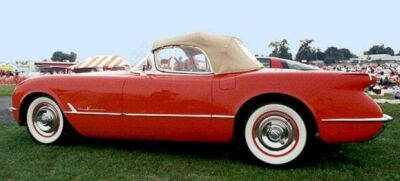 Comments:
Sales fell to just 700 units in 1955, leading to a push within GM to kill
the Corvette. However, Zora Arkus-Duntov, an engineer on the Corvette team
since 1953 and a former European road racer, was determined to save the
Corvette and make it a contender. He started by giving the Corvette the
two things it needed the most, more power and better handling. By mid-1955,
more power was added with the addition of a 265 cid V8 rated at 195 bhp
as well as the option of a 3-speed manual transmission. Meanwhile, Duntov
drove a prototype V8 powered Corvette to a new record in the Daytona "Measured
Mile" at just over 150 mph which gained some much needed recognition for
the Corvette. The Corvette was officially saved and Duntov would be remember
as the "grandfather of the Corvette" for his efforts. Comments:
Sales fell to just 700 units in 1955, leading to a push within GM to kill
the Corvette. However, Zora Arkus-Duntov, an engineer on the Corvette team
since 1953 and a former European road racer, was determined to save the
Corvette and make it a contender. He started by giving the Corvette the
two things it needed the most, more power and better handling. By mid-1955,
more power was added with the addition of a 265 cid V8 rated at 195 bhp
as well as the option of a 3-speed manual transmission. Meanwhile, Duntov
drove a prototype V8 powered Corvette to a new record in the Daytona "Measured
Mile" at just over 150 mph which gained some much needed recognition for
the Corvette. The Corvette was officially saved and Duntov would be remember
as the "grandfather of the Corvette" for his efforts.
Production: Convertible:
700.
Engines: 235 I6 150
bhp @ 4200 rpm, 223 lb-ft @ 2400 rpm. 265 V8 195 bhp.
1956 Chevrolet
Corvette
Comments: The Corvette
received its first major styling change in 1956. Changes included an all-new
body with better integrated styling featuring "scooped out" sides, outside
door handles, roll-up windows and an optional removable hardtop. The 6
cylinder engine was dropped and the 265 cid V8 was now standard, though
it was still rated at just 195 bhp.
Production: Convertible:
3,467.
Engines: 265 V8 195
bhp.
1957 Chevrolet
Corvette
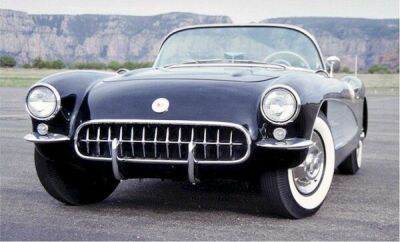 Comments:
Chevrolet finally got their sports car right for 1957, as the 1957 Corvette
finally gained power to go along with its outstanding styling and road
feel. Many Corvette enthusiasts consider the 1957 Corvette was the most
aesthetically pleasing body style of the pre-1963 Corvettes, while others
believe that it was the best styling of all time. And backing up that beautiful
styling was the Corvette's first true powerful engine, a 283 cid V8. A
bored out version of the 1956 265 cid V8, the new 283 cid V8 came in four
versions. The base form had a four-barrel carb and was rated at 220 bhp.
Next came an early fuel injected version rated at 250 bhp and then the
dual four-barrel carb 283 rated at 270 bhp. But late in the model year,
in May 1957, the true performance version of the 283 made its debut. Sporting
an advanced fuel injection system, the new "fuelie" 283 made 283 bhp. Its
1 horsepower per cubic inch output was a record in 1957 and it was played
up by the advertising and media. At the same time, Chevrolet introduced
its new four speed manual transmission, and the Corvette was on its way
to stardom. When equipped with the 283 fuelie engine, 4.11:1 rear axle,
and the new four-speed Borg-Warner T-10 transmission, the Corvette could
accelerate from 0-60 in less than six seconds, and do the quarter mile
in the low 14 second range at over 100 mph. For those that wanted even
more performance, Chevrolet offered two option packages. Checking RPO 579E
got the buyer the fuel-injected 283 cid V8 with cold-air induction and
a big tachometer on the steering wheel. There also was special race only
package, coded RPO 684, which was strictly for off road (track only), and
consisted of heavy-duty springs and shocks and sway bar, a positraction
rear axle, quicker ratio steering and metallic brakes. Comments:
Chevrolet finally got their sports car right for 1957, as the 1957 Corvette
finally gained power to go along with its outstanding styling and road
feel. Many Corvette enthusiasts consider the 1957 Corvette was the most
aesthetically pleasing body style of the pre-1963 Corvettes, while others
believe that it was the best styling of all time. And backing up that beautiful
styling was the Corvette's first true powerful engine, a 283 cid V8. A
bored out version of the 1956 265 cid V8, the new 283 cid V8 came in four
versions. The base form had a four-barrel carb and was rated at 220 bhp.
Next came an early fuel injected version rated at 250 bhp and then the
dual four-barrel carb 283 rated at 270 bhp. But late in the model year,
in May 1957, the true performance version of the 283 made its debut. Sporting
an advanced fuel injection system, the new "fuelie" 283 made 283 bhp. Its
1 horsepower per cubic inch output was a record in 1957 and it was played
up by the advertising and media. At the same time, Chevrolet introduced
its new four speed manual transmission, and the Corvette was on its way
to stardom. When equipped with the 283 fuelie engine, 4.11:1 rear axle,
and the new four-speed Borg-Warner T-10 transmission, the Corvette could
accelerate from 0-60 in less than six seconds, and do the quarter mile
in the low 14 second range at over 100 mph. For those that wanted even
more performance, Chevrolet offered two option packages. Checking RPO 579E
got the buyer the fuel-injected 283 cid V8 with cold-air induction and
a big tachometer on the steering wheel. There also was special race only
package, coded RPO 684, which was strictly for off road (track only), and
consisted of heavy-duty springs and shocks and sway bar, a positraction
rear axle, quicker ratio steering and metallic brakes.
Production: Convertible:
6,339
Engines: 283 V8 (4
bbl) 220 bhp. 283 V8 (FI) 250 bhp. 283 V8 (2x4 bbl) 270 bhp. 283 V8 ("fuelie")
283 bhp.
Performance: 283/283:
0-60 in 5.9 seconds, 1/4 mile in 14.3 seconds @ 100 mph.
1958 Chevrolet
Corvette
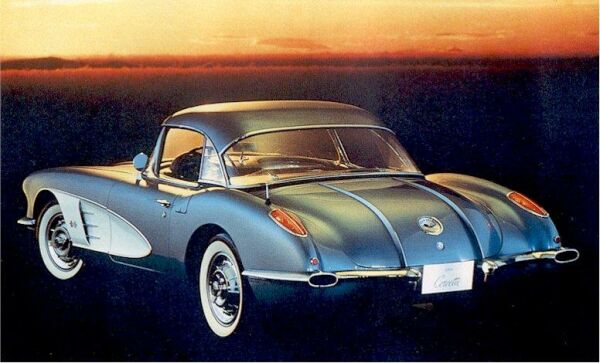
Comments: The Corvette
continued to improve for 1958 as the fuel injected 283 V8 now produced
up to 290 bhp and the Corvette received a new body design which featured
four headlights. Also new was the washboard hood which featured simulated
louvers and twin decklid chrome strips.
Production: Convertible:
9,168
Engines: 283 V8 (4
bbl) 220 bhp. 283 V8 (FI) 250 bhp. 283 V8 (2x4 bbl) 270 bhp. 283 V8 ("fuelie")
283 bhp.
1959 Chevrolet
Corvette
Comments: The 1959
Corvette lost its simulated louvers and twin decklid chrome strips on the
hood.
Production: Convertible:
9,670
Engines: 283 V8 (4
bbl) 220 bhp. 283 V8 (FI) 250 bhp. 283 V8 (2x4 bbl) 270 bhp. 283 V8 ("fuelie")
283 bhp.
1960 Chevrolet
Corvette
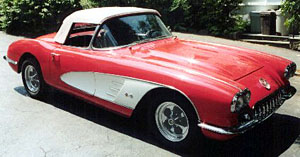
Comments: The 1960
Corvette saw an increased use of aluminum and a new rear anti-sway bar
to improve handling. Corvette production topped 10,000 units for the first
time.
Production: Convertible:
10,261
Engines: 283 V8 (4
bbl) 220 bhp. 283 V8 (FI) 250 bhp. 283 V8 (2x4 bbl) 270 bhp. 283 V8 ("fuelie")
283 bhp.
1961 Chevrolet
Corvette
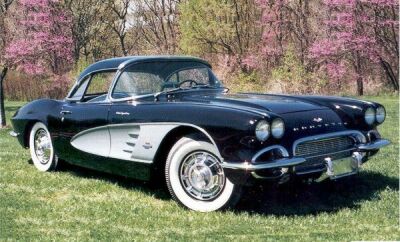 Comments:
1961 saw the first use of Corvette's now trademark quad tailights and was
the last year to feature wide whitewall tires. The exterior styling was
midly facelifted with Bill Mitchell's duck-tail rear end and a simplified
mesh grille without the previous versions' "teeth." Comments:
1961 saw the first use of Corvette's now trademark quad tailights and was
the last year to feature wide whitewall tires. The exterior styling was
midly facelifted with Bill Mitchell's duck-tail rear end and a simplified
mesh grille without the previous versions' "teeth."
Production: Convertible:
10,939
Engines: 283 V8 (4
bbl) 220 bhp. 283 V8 (FI) 250 bhp. 283 V8 (2x4 bbl) 270 bhp. 283 V8 ("fuelie")
283 bhp.
1962 Chevrolet
Corvette
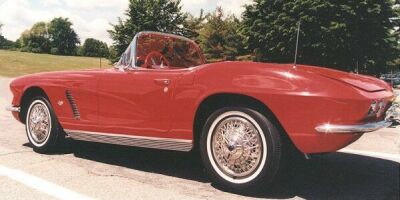 Comments:
The last of the straight axle Corvettes was the first to offer a Chevy
327 cid small block V8. It was offered in three forms, with the top reserved
for a special race package, called "Sebring." Due to the racing ban of
1957, Chevrolet was not allowed to support factory racing. Because of this,
the "grandfather" of the Corvette, Zora Arkus-Duntoz slipped in several
serious racing parts on to the Corvette options list. The Corvette was
a true sports car, as power steering, power brakes, and air condition were
not available. Performance buyers, however, could order hot "Duntov" camshafts,
thermo-activated cooling fans, and aluminum-cased transmissions. Also available
was a special racing package, called "Sebring." Available options on the
Sebring included 15x5.5 inch wheels (no charge), a direct-flow exhaust
system (no charge), a 24-gallon fuel tank (8.40), four-speed gearbox
(8.30), Posi-Traction rear axle (.05), sintered metallic brake linings
(.70), and a heavy-duty suspension (3.60). The most desired option
was the 327 V8 "fuelie" rated at a whooping 370 bhp which cost 4.20.
With a low 3,080 pound curb weight, a 327/380 equipped Corvette had a power-weight
of just 8.6 lbs per horsepower, the lowest ratio ever, up to that point.
This combination was good for 0-60 in just 5.9 seconds and run the quarter
mile in 14.9 seconds. Exterior styling changes included de-emphasized bodyside
cove sculpture and a blacked-out grille. Comments:
The last of the straight axle Corvettes was the first to offer a Chevy
327 cid small block V8. It was offered in three forms, with the top reserved
for a special race package, called "Sebring." Due to the racing ban of
1957, Chevrolet was not allowed to support factory racing. Because of this,
the "grandfather" of the Corvette, Zora Arkus-Duntoz slipped in several
serious racing parts on to the Corvette options list. The Corvette was
a true sports car, as power steering, power brakes, and air condition were
not available. Performance buyers, however, could order hot "Duntov" camshafts,
thermo-activated cooling fans, and aluminum-cased transmissions. Also available
was a special racing package, called "Sebring." Available options on the
Sebring included 15x5.5 inch wheels (no charge), a direct-flow exhaust
system (no charge), a 24-gallon fuel tank (8.40), four-speed gearbox
(8.30), Posi-Traction rear axle (.05), sintered metallic brake linings
(.70), and a heavy-duty suspension (3.60). The most desired option
was the 327 V8 "fuelie" rated at a whooping 370 bhp which cost 4.20.
With a low 3,080 pound curb weight, a 327/380 equipped Corvette had a power-weight
of just 8.6 lbs per horsepower, the lowest ratio ever, up to that point.
This combination was good for 0-60 in just 5.9 seconds and run the quarter
mile in 14.9 seconds. Exterior styling changes included de-emphasized bodyside
cove sculpture and a blacked-out grille.
Production: 14,531
Engines: 327 V8 ("fuelie")
370 bhp.
Performance: 327/370:
0-60 in 5.9 seconds, 1/4 mile in 14.9 seconds.
1963 Chevrolet
Corvette
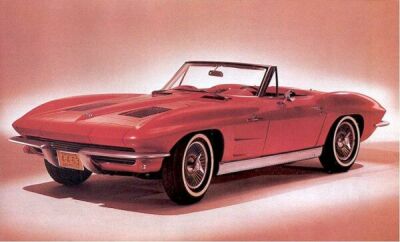 Comments:
The second generation Corvette was launched in 1963 and saw the debut of
the gorgeous Sting Ray body. A two passenger coupe body style joined the
convertible for the first time and featured a split rear-window design.
The Corvette featured an independent rear suspension (replacing the previous
version's straight axle), fuel-injection, and knock off wheels. It even
had a racing option, the Z-06. The Z-06 was created by Zora Arkus-Duntoz
as a purpose built (through non-descript) racer, although its thunder was
stolen by the superior Shelby Cobra. Nevertheless, the Z-06 option consisted
of a fuel-injected 327 cid V8, 36.5 gallon fuel tank, heavy-duty brakes,
heavy-duty suspension, and knock-off wheels. The heavy-duty brakes consisted
of drums with sintered metallic linings, power assisted and backed by a
dual circuit master cylinder. "Elephant ear" scoops rammed fresh air to
the drums and cooling fans spun with the hub. The 36.5 gallon fuel tank
(coded N03), just fit in the back of the coupe body style and helped the
Corvette better compete in long distance endurance racing events, such
as Daytona. About 60 of the 199 Z-06 Corvettes had the N03, and those Corvettes
included inner wheel well housings modified to fit larger-than-stock tires.
The knock off wheels, which became synonymous with the 1963 split window
Corvette, actually leaded due to porosity of the aluminum and poor sealing
at the rims, and no more than a dozen coupes and roadsters got them. Luxury
options such as power steering, air conditioning, and leather seats were
available for the first time on Corvettes. Comments:
The second generation Corvette was launched in 1963 and saw the debut of
the gorgeous Sting Ray body. A two passenger coupe body style joined the
convertible for the first time and featured a split rear-window design.
The Corvette featured an independent rear suspension (replacing the previous
version's straight axle), fuel-injection, and knock off wheels. It even
had a racing option, the Z-06. The Z-06 was created by Zora Arkus-Duntoz
as a purpose built (through non-descript) racer, although its thunder was
stolen by the superior Shelby Cobra. Nevertheless, the Z-06 option consisted
of a fuel-injected 327 cid V8, 36.5 gallon fuel tank, heavy-duty brakes,
heavy-duty suspension, and knock-off wheels. The heavy-duty brakes consisted
of drums with sintered metallic linings, power assisted and backed by a
dual circuit master cylinder. "Elephant ear" scoops rammed fresh air to
the drums and cooling fans spun with the hub. The 36.5 gallon fuel tank
(coded N03), just fit in the back of the coupe body style and helped the
Corvette better compete in long distance endurance racing events, such
as Daytona. About 60 of the 199 Z-06 Corvettes had the N03, and those Corvettes
included inner wheel well housings modified to fit larger-than-stock tires.
The knock off wheels, which became synonymous with the 1963 split window
Corvette, actually leaded due to porosity of the aluminum and poor sealing
at the rims, and no more than a dozen coupes and roadsters got them. Luxury
options such as power steering, air conditioning, and leather seats were
available for the first time on Corvettes.
Production: Coupe:
10,594. Convertible: 10,919. Z-06: 199
Engines: 327 V8 250
bhp. 327 V8 300 bhp. 327 V8 350 bhp. 327 V8 365 bhp. 327 V8 ("fuelie")
370 bhp.
Performance: 327/370:
0-60 in 5.9 seconds, 1/4 mile in 14.9 seconds.
1964 Chevrolet
Corvette
Comments: The 1964
Corvette featured several improvements such as higher horsepower "fuelie"
engine options, a smoother ride, and better insulation. The hardtop lost
its split rear-window design in favor of a more conventional single-piece
rear window, because owners of 1963 Corvettes complained about rear visibility.
Production: Coupe:
8,304. Convertible: 13,925.
Engines: 327 V8 250
bhp. 327 V8 300 bhp. 327 V8 350 bhp. 327 V8 365 bhp. 327 V8 ("fuelie")
375 bhp.
1965 Chevrolet
Corvette
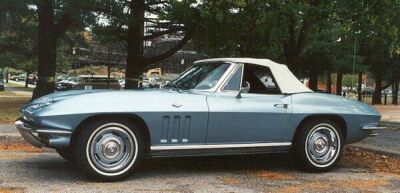 Comments:
1965 saw several changes to the Corvette. The big news was the addition
of standard four-wheel disc brakes. Styling changes were at a minimum,
with functional front fender louvers, new wheel covers, and a restyled
grille. The hood had no depressions or trim, and thus was not interchangeable
with the '63 or '64 Corvettes. Inside, newly styled bucket seats were offered
and genuine leather seating surfaces were optional. Options few European
cars could match included power steering, power brakes, power windows,
air conditioning, AM-FM radio, telescopic steering column, and a wood-rimmed
steering wheel. Under the hood, the Corvette offered a wide range of engines.
Standard was Chevy's tried-and-true 327 cid Turbo Fire V8 rated at 250
bhp. Next up was a 300 bhp version of the 327 and new for 1965 was the
precursor to the famous LT1, a 327 rated at 350 bhp. At the top, was the
most powerful carbureted 327, rated at 365 bhp. For true performance buyers,
the Ram-Jet Fuel-Injected 327 made its last appearance in 1965. At 8,
fuel injection was an expensive option, but it made 327 a 375 bhp stormer.
It was the ultimate small block V8. But the introduction in April 1965,
of the 396 cid big block MK IV V8 marked the beginning of a new era for
the Corvette. Rated at 425 bhp and priced at only 2.70, the 396 V8 big
block was a direct descendant of the 427 cid MK II engine that dominated
NASCAR in 1963, and made the 327 "fuelie" seem superfluous in an era of
cheap, high octane gasoline. A special bulging hood was included when the
396 was ordered. Interestingly, this would be the only year for the 396
V8. Although the 327 "fuelie" was still available through the 1965 model
year, it was quietly dropped when the 1966 Corvettes was introduced. Introduced
at the same time as the 396 were new side-mounted exhausts, a 4.50 option.
1965 was a unique and mememorable year for the Corvette. It was the only
year that you could buy a fuel-injected, disc-braked Sting Ray. It was
the first year for the big block and side-mounted exhausts. And with prices
starting at ,106, the 1965 Corvette Sting Ray was quite a bargin. No
wonder that sales reached a record 23,652 units. Comments:
1965 saw several changes to the Corvette. The big news was the addition
of standard four-wheel disc brakes. Styling changes were at a minimum,
with functional front fender louvers, new wheel covers, and a restyled
grille. The hood had no depressions or trim, and thus was not interchangeable
with the '63 or '64 Corvettes. Inside, newly styled bucket seats were offered
and genuine leather seating surfaces were optional. Options few European
cars could match included power steering, power brakes, power windows,
air conditioning, AM-FM radio, telescopic steering column, and a wood-rimmed
steering wheel. Under the hood, the Corvette offered a wide range of engines.
Standard was Chevy's tried-and-true 327 cid Turbo Fire V8 rated at 250
bhp. Next up was a 300 bhp version of the 327 and new for 1965 was the
precursor to the famous LT1, a 327 rated at 350 bhp. At the top, was the
most powerful carbureted 327, rated at 365 bhp. For true performance buyers,
the Ram-Jet Fuel-Injected 327 made its last appearance in 1965. At 8,
fuel injection was an expensive option, but it made 327 a 375 bhp stormer.
It was the ultimate small block V8. But the introduction in April 1965,
of the 396 cid big block MK IV V8 marked the beginning of a new era for
the Corvette. Rated at 425 bhp and priced at only 2.70, the 396 V8 big
block was a direct descendant of the 427 cid MK II engine that dominated
NASCAR in 1963, and made the 327 "fuelie" seem superfluous in an era of
cheap, high octane gasoline. A special bulging hood was included when the
396 was ordered. Interestingly, this would be the only year for the 396
V8. Although the 327 "fuelie" was still available through the 1965 model
year, it was quietly dropped when the 1966 Corvettes was introduced. Introduced
at the same time as the 396 were new side-mounted exhausts, a 4.50 option.
1965 was a unique and mememorable year for the Corvette. It was the only
year that you could buy a fuel-injected, disc-braked Sting Ray. It was
the first year for the big block and side-mounted exhausts. And with prices
starting at ,106, the 1965 Corvette Sting Ray was quite a bargin. No
wonder that sales reached a record 23,652 units.
Production: Coupes:
8,186. Convertibles: 15,376.
Engines: 327 V8 250
bhp. 327 V8 300 bhp. 327 V8 350 bhp. 327 V8 365 bhp. 327 V8 ("fuelie")
375 bhp. 396 V8 425 bhp.
Performance: 396/425:
0-60 in 5.7 seconds, 1/4 mile in 14.1 seconds @ 103 mph.
1966 Chevrolet
Corvette
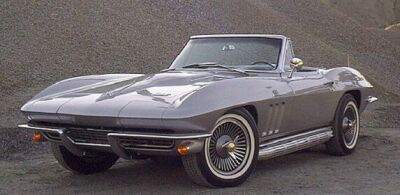 Comments:
The 1966 Corvette featured a new eggcrate grille and functional engine
compartment cooling vents. The previous year's 396 V8 was dropped. In its
place, a new muscle Corvette was introduced, the "427" with its own funnel-shaped,
power bulge on the hood. There were two of these big blocks at first. RPO
L36, priced at 1, was rated at 390 bhp. RPO L72, with a 2 price tag,
was rated at 425 bhp. Both engines were related to the "mystery" 427 and
the production Turbo Jet 396. The 427/425 bhp Corvette convertible could
hit 60 mph in just 5.7 seconds, and the quarter mile in 14 seconds. It
boasted a power-to-weight ratio of just 7.7 lbs per horsepower. "427 Turbo
Jet" crossed racing flag emblems appeared above the cooling vents. Three
four speed gearboxes -- wide ratio, close-ratio, and heavy-duty close ratio
were optional. Side-mounted exhuast pipes were optional. A total of 5,116
L36s and 5,258 L72s were built, therefore 38% of the 1966 Corvettes were
427s. Comments:
The 1966 Corvette featured a new eggcrate grille and functional engine
compartment cooling vents. The previous year's 396 V8 was dropped. In its
place, a new muscle Corvette was introduced, the "427" with its own funnel-shaped,
power bulge on the hood. There were two of these big blocks at first. RPO
L36, priced at 1, was rated at 390 bhp. RPO L72, with a 2 price tag,
was rated at 425 bhp. Both engines were related to the "mystery" 427 and
the production Turbo Jet 396. The 427/425 bhp Corvette convertible could
hit 60 mph in just 5.7 seconds, and the quarter mile in 14 seconds. It
boasted a power-to-weight ratio of just 7.7 lbs per horsepower. "427 Turbo
Jet" crossed racing flag emblems appeared above the cooling vents. Three
four speed gearboxes -- wide ratio, close-ratio, and heavy-duty close ratio
were optional. Side-mounted exhuast pipes were optional. A total of 5,116
L36s and 5,258 L72s were built, therefore 38% of the 1966 Corvettes were
427s.
Production: Coupes:
9,958. Convertibles: 17,762.
Engines: 427 V8 (L36)
390 bhp. 427 V8 (L72) 425 bhp.
Performance: 427/425:
0-60 in 5.7 seconds, 1/4 mile in 14 seconds.
1967 Chevrolet
Corvette
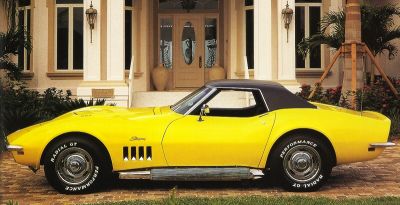 Comments:
For 1967, the Corvette got additional engine cooling vents, and 427s got
a different "power bulge" hood and more top horsepower. The new hood had
a large, forward facing air scoop, usually with engine call-outs on both
sides. The standard engine was a 327 V8 rated at 300 bhp. But for performance
fans, there were four versions of the 427 available. The first version,
the L36, cost just 0 more and featured a single four barrel carb, 10.25:1
compression and hydraulic lifters. It was rated at a stout 390 bhp. Next
up was the L68 for 5 which featured triple two-barrel Holley carbs (a
first for Corvette) and was good for 400 bhp. At the top was the L71 with
triple two-barrel Holley carbs, solid lifters, special performance cams,
and 11:1 compression which was conservatively rated at 435 bhp. Extremely
rare (only 20 were built) was the top of the line L88 for 8 more. The
L88 featured new aluminum heads, 12.5:1 compression, and a single Holley
four barrel carb rated at 850 cfm that sat on an aluminum intake manifold
with a special raised plenum chamber. In addition, you got a transistor
ignition and Positraction differential but didn't get a fan shroud, heater,
nor defroster. Chevrolet was reluctant about revealing the engine's true
potential and officially rated at only 430 bhp, but most experts believed
that it in fact developed close to 600 bhp! In all, 9,707 big-blocks were
built, meaning that 42.31% of all 1967 Corvettes were 427s. Transmission
choices were relatively simple. With the L36 and L68, buyers could choose
between the wide-ratio (4) or close-ratio (4) four-speed manuals,
or Powerglide automatic transmission (4). The L71 came only with the
close-ratio four-speed. Rear end gear ratios ranged from 3.08 to 4.11.
Other options included side-mounted exhausts at 2, cast aluminum bolt-on
wheels at 3 and detachable hardtop for the convertible for 2. Comments:
For 1967, the Corvette got additional engine cooling vents, and 427s got
a different "power bulge" hood and more top horsepower. The new hood had
a large, forward facing air scoop, usually with engine call-outs on both
sides. The standard engine was a 327 V8 rated at 300 bhp. But for performance
fans, there were four versions of the 427 available. The first version,
the L36, cost just 0 more and featured a single four barrel carb, 10.25:1
compression and hydraulic lifters. It was rated at a stout 390 bhp. Next
up was the L68 for 5 which featured triple two-barrel Holley carbs (a
first for Corvette) and was good for 400 bhp. At the top was the L71 with
triple two-barrel Holley carbs, solid lifters, special performance cams,
and 11:1 compression which was conservatively rated at 435 bhp. Extremely
rare (only 20 were built) was the top of the line L88 for 8 more. The
L88 featured new aluminum heads, 12.5:1 compression, and a single Holley
four barrel carb rated at 850 cfm that sat on an aluminum intake manifold
with a special raised plenum chamber. In addition, you got a transistor
ignition and Positraction differential but didn't get a fan shroud, heater,
nor defroster. Chevrolet was reluctant about revealing the engine's true
potential and officially rated at only 430 bhp, but most experts believed
that it in fact developed close to 600 bhp! In all, 9,707 big-blocks were
built, meaning that 42.31% of all 1967 Corvettes were 427s. Transmission
choices were relatively simple. With the L36 and L68, buyers could choose
between the wide-ratio (4) or close-ratio (4) four-speed manuals,
or Powerglide automatic transmission (4). The L71 came only with the
close-ratio four-speed. Rear end gear ratios ranged from 3.08 to 4.11.
Other options included side-mounted exhausts at 2, cast aluminum bolt-on
wheels at 3 and detachable hardtop for the convertible for 2.
Production: Coupes:
14,436. Convertibles: 8,504.
Engines: 327 V8 300
bhp. 427 V8 (L36) 390 bhp. 427 V8 (L68) 400 bhp. 427 V8 (L71) 435 bhp @
5800 rpm. 427 V8 (L88) 430 bhp.
1968 Chevrolet
Corvette
Comments: The all
new 1968 Corvette was a dramatic change in appearance from previous Corvettes.
The all new styling bore a striking resemblence to Chevrolet's Mako Shark
II concept car and was a bold look. The new Corvette also introduced hidden
windshield wipers and removable T-tops on Coupe models. Under the hood,
the Corvette gained several interesting engine options, including the 327
cid V8 L79 rated at 350 bhp, and the L89 aluminum head option for the L71.
Corvette production hit a new record of 28,566 units.
Production: Coupes:
9,936. Convertibles: 18,630.
Engines: 327 V8 300
bhp. 327 V8 (L79) 350 bhp. 427 V8 (L36) 390 bhp. 427 V8 (L68) 400 bhp.
427 V8 (L71) 435 bhp @ 5800 rpm. 427 V8 (L88) 430 bhp.
1969 Chevrolet
Corvette
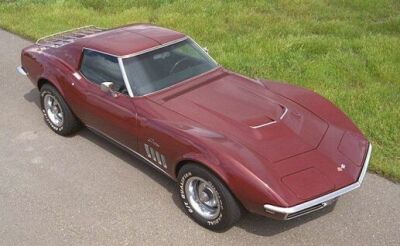 Comments:
The Corvette was basically carry over for 1969, though now officially called
the "Stingray" (one word) The coupe outsold the convertible for the first
time, and would continue to do so in all subsequent years. Engine choices
were changed with a new 350 cid V8 replacing the previous 327. In addition,
two Corvettes were built with the ZL1 engine (a total of 69 Camaros also
received this engine). One was a canary yellow car with sidepipers and
the other was a Can-Am white t-top coupe with black ZL1 stipes. Technically,
the ZL-1 was a ,010 option that consisted of an assortment of aluminum
cylinder block and heads on top of the ,032.15 L88 race option. The ZL-1
featured thicker walls and main webbing, along with dry sump lubricating
provisions. The bottom end was four-bolt, with a forged steel crank and
rods with 7/16 inch bolts, Spiralock washers and full floating pins. Pistons
were even higher domed than the L88s, yielding a compression ratio of 12.5:1.
Cylinder heads were also aluminum and featured open combustion chambers
and round exhaust ports and 2.19 inch/1.88 inch valves, a configuration
adopted by the L88 in mid-1969. The aluminum dual plane intake was topped
by a 850 cfm Holley four-barrel (double pumper) carburetor featuring mechanical
secondaries. The ZL1's solid lifter camshaft was radical, so the engine
could live in the upper revs. Comments:
The Corvette was basically carry over for 1969, though now officially called
the "Stingray" (one word) The coupe outsold the convertible for the first
time, and would continue to do so in all subsequent years. Engine choices
were changed with a new 350 cid V8 replacing the previous 327. In addition,
two Corvettes were built with the ZL1 engine (a total of 69 Camaros also
received this engine). One was a canary yellow car with sidepipers and
the other was a Can-Am white t-top coupe with black ZL1 stipes. Technically,
the ZL-1 was a ,010 option that consisted of an assortment of aluminum
cylinder block and heads on top of the ,032.15 L88 race option. The ZL-1
featured thicker walls and main webbing, along with dry sump lubricating
provisions. The bottom end was four-bolt, with a forged steel crank and
rods with 7/16 inch bolts, Spiralock washers and full floating pins. Pistons
were even higher domed than the L88s, yielding a compression ratio of 12.5:1.
Cylinder heads were also aluminum and featured open combustion chambers
and round exhaust ports and 2.19 inch/1.88 inch valves, a configuration
adopted by the L88 in mid-1969. The aluminum dual plane intake was topped
by a 850 cfm Holley four-barrel (double pumper) carburetor featuring mechanical
secondaries. The ZL1's solid lifter camshaft was radical, so the engine
could live in the upper revs.
Production: Coupes:
22,154. Convertibles: 16,608.
Engines: 350 V8 300
bhp. 350 V8 350 bhp. 350 V8 (LT1) 370 bhp. 427 V8 (L36) 390 bhp. 427 V8
(L68) 400 bhp. 427 V8 (L71) 435 bhp @ 5800 rpm. 427 V8 (L88) 430 bhp.
Performance: 427/430
(ZL1): 1/4 mile in 12.1 seconds @ 116 mph.
1970 Chevrolet
Corvette
Comments: Chevy's
new 454 V8 replaced the firebreathing 427s for 1970. But while the Chevrolet
Chevelle SS received Chevy's top engine, the 454 LS6 rated at 450 bhp,
the Corvette had to make due with the 454 LS5 rated at 390 bhp. Despite
rumors to the contrary, the Corvette never received the LS7 engine, an
iron block/aluminum head 454 race motor rated at 465 bhp nor the LT2 454.
A total of 17,316 units were sold in 1970.
Production:
Coupes: 10,668. Convertibles: 6,648.
Engines: 350 V8 300
bhp. 350 V8 350 bhp. 350 V8 (LT1) 370 bhp. 454 V8 (LS5) 390 bhp.
Performance: 350/370:
0-60 in 5.7 seconds, 1/4 mile in 14.2 seconds.
1971 Chevrolet
Corvette
Comments: The Corvette
finally received the powerful LS6 454 engine for 1971, but it was now detuned
to run on unleaded gas and was rated at 425 bhp, down 25 bhp from the 1970
Chevrolet Chevelle SS. Interestingly, only 188 LS6 Corvettes were built,
with 12 more appearing under RPO ZR2, the factory racing package.
Production: Coupes:
14,680. Convertibles: 7,121.
Engines: 350 V8 300
bhp. 350 V8 350 bhp. 350 V8 (LT1) 370 bhp. 454 V8 (LS5) 390 bhp.
1972 Chevrolet
Corvette
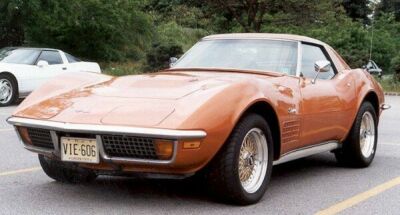 Comments:
Engine power ratings dropped across the board as GM ordered that all its
engines be rated using the new SAE net method, which rated an engine with
all accessories attached. True output remained similar to 1971 and the
Corvette was still quite a performer. Comments:
Engine power ratings dropped across the board as GM ordered that all its
engines be rated using the new SAE net method, which rated an engine with
all accessories attached. True output remained similar to 1971 and the
Corvette was still quite a performer.
Production: Coupes:
20,486. Convertibles: 6,508.
Engines: 350 V8 200
bhp (net). 350 V8 210 bhp (net). 350 V8 255 bhp (net). 350 V8 (LT1) 275
bhp (net). 454 V8 270 bhp. 454 V8 285 bhp. 454 V8 (LS5) 325 bhp.
Performance: 350/255:
0-60 in 6.9 seconds, 1/4 mile in 14.3 seconds.
1973 Chevrolet
Corvette
Comments: The 1973
Corvette was the fifth generation "Shark" which debuted in the years of
the first energy crisis. The 1973 Corvette was unique among Corvettes in
combining a smooth body-colored nose with the original 1968-vintage "Kamm"
tail. The engines were further detuned for cleaner emissions, which resulted
in lower engine outputs. Generally, the styling was cleaner than previous
years, with a rear hood extension to cover the windshield wipers (instead
of a pop-up panel), and a fixed coupe backlight instead of a removeable
one. The new Corvette was also improved with standard radial tires, a more
efficient Turbo Hydra-Matic automatic transmission option, and combined
lap/shoulder belts. Of particular interest to enthusiasts was the availability
of the RPO FE7 Gymkhana suspension (high-rate springs/shocks for only )
and the similar Z07 option (with heavy-duty brakes).
Production: Coupes:
24,372. Convertibles: 6,093.
Engines: 350 V8 190
bhp (net). 350 V8 200 bhp (net). 350 V8 250 bhp (net). 454 V8 270 bhp.
454 V8 275 bhp.
1974 Chevrolet
Corvette
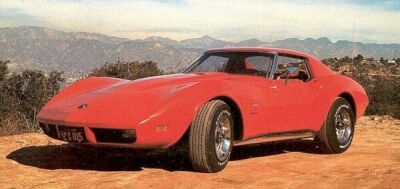 Comments:
The 1974 Corvette received a new smooth body-color rear end to match the
front styling. The new rear end also hid the new Federal mandated 5 mph
bumpers. Bowing to increasing government regulations, 1974 would be the
last year for the big block engines and true dual exhausts, among other
things. Comments:
The 1974 Corvette received a new smooth body-color rear end to match the
front styling. The new rear end also hid the new Federal mandated 5 mph
bumpers. Bowing to increasing government regulations, 1974 would be the
last year for the big block engines and true dual exhausts, among other
things.
Production: Coupes:
32,028. Convertibles: 4,629.
Engines: 350 V8 190
bhp (net). 350 V8 200 bhp (net). 350 V8 250 bhp (net). 454 V8 270 bhp.
454 V8 275 bhp.
1975 Chevrolet
Corvette
Comments: Engine
output hit rock bottom with the 1975 Corvettes, as big blocks were no longer
available and the top 350 cid V8 was rated at just 205 bhp. Changes were
few, and included the addition of small black-rubber bumper pads and electronic
ignition. 1975 would be the last year for the Convertible, as falling sales
and a threatened government mandated rollover standard (that never materialized),
sealed its fate.
Production: Coupes:
33,836. Convertibles: 4,629.
Engines: 350 V8 165
bhp (net). 350 V8 205 bhp (net).
1976 Chevrolet
Corvette
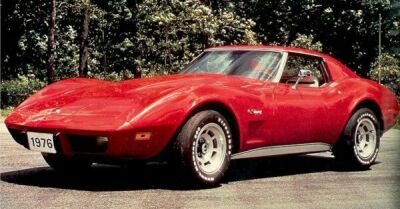 Comments:
Engine output climbed for 1976, due to higher compression ratios made possible
by a newly adopted catalytic converter. A new four-spoke steering wheel
was added and the rear-deck air-extractor vents were removed. Comments:
Engine output climbed for 1976, due to higher compression ratios made possible
by a newly adopted catalytic converter. A new four-spoke steering wheel
was added and the rear-deck air-extractor vents were removed.
Production: Coupes:
46,558.
Engines: 350 V8 180
bhp (net). 350 V8 210 bhp (net).
1977 Chevrolet
Corvette
Comments: The "Stingray"
name was officially dropped for the 1977 Corvettes. Changes included revamped
controls and center console, standard leather upholstery, and no-cost power
steering and brakes.
Production: Coupes:
49,213.
Engines: 350 V8 180
bhp (net). 350 V8 210 bhp (net).
1978 Chevrolet
Corvette
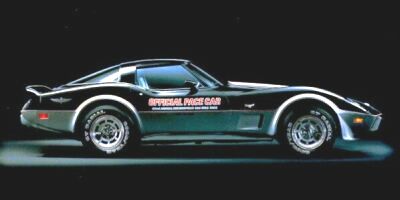 Comments:
The Corvette celebrated its 25th Anniversary in 1978, and all Corvettes
received special commemorative emblems. All 1978 Corvettes received a new
fastback roofline with a large, wraparound backlight. A four-speed manual
was reinstated as standard, and a higher-output 350 cid V8 was available,
though only with the automatic transmission. But the big news for enthusiasts
was the addition of two limited edition versions of the Corvette. The true
Anniversary editions were those Corvettes ordered with the "25th Anniversary
Paint" B2Z option. It was a distinctive two-tone silver paint treatment
with a silver metallic upper body color and a charcoal silver lower body
color. Pin stripes accentuated the front upper profiles, wheel openings,
front fender vents, bood, and rear license cavity. The optional aluminum
wheels and dual sport mirrors were required. The second limited edition
Corvette was the Pace Car Replica model, which commemorated the Corvettes
which paced the 62nd Indy 500. The Pace Car Replica was decked out with
a black upper body and silver-metallic lower body, plus the alloy wheels
and fat Goodyear tires worn by the Silver Anniversary model. The Pace Car
Replica also carried front and rear spoilers and the identifying "Pace
Car" decals were supplied separately so the owner could apply them if desired.
Upholstery choices were either silver leather or a silver leather/gray
cloth combination. The seats were a new design scheduled for the 1979 Corvettes.
Standard equipment included power windows, electric rear window defroster,
air conditioning, sport mirrors, and other features which boosted the price
of the Pace Car Replica over ,000 more than the base Corvette. Because
of its announced limited availability, new Pace Car Replicas fetched upwards
of ,000 and a flood of "fake" Pace Car Replicas flooded the market,
then and now. The only true clues to a real Pace Car Replica are the seats
which should resemble a 1979 Corvette more than the 1978 ones, and the
serial number, which should be between 900001-906502. Comments:
The Corvette celebrated its 25th Anniversary in 1978, and all Corvettes
received special commemorative emblems. All 1978 Corvettes received a new
fastback roofline with a large, wraparound backlight. A four-speed manual
was reinstated as standard, and a higher-output 350 cid V8 was available,
though only with the automatic transmission. But the big news for enthusiasts
was the addition of two limited edition versions of the Corvette. The true
Anniversary editions were those Corvettes ordered with the "25th Anniversary
Paint" B2Z option. It was a distinctive two-tone silver paint treatment
with a silver metallic upper body color and a charcoal silver lower body
color. Pin stripes accentuated the front upper profiles, wheel openings,
front fender vents, bood, and rear license cavity. The optional aluminum
wheels and dual sport mirrors were required. The second limited edition
Corvette was the Pace Car Replica model, which commemorated the Corvettes
which paced the 62nd Indy 500. The Pace Car Replica was decked out with
a black upper body and silver-metallic lower body, plus the alloy wheels
and fat Goodyear tires worn by the Silver Anniversary model. The Pace Car
Replica also carried front and rear spoilers and the identifying "Pace
Car" decals were supplied separately so the owner could apply them if desired.
Upholstery choices were either silver leather or a silver leather/gray
cloth combination. The seats were a new design scheduled for the 1979 Corvettes.
Standard equipment included power windows, electric rear window defroster,
air conditioning, sport mirrors, and other features which boosted the price
of the Pace Car Replica over ,000 more than the base Corvette. Because
of its announced limited availability, new Pace Car Replicas fetched upwards
of ,000 and a flood of "fake" Pace Car Replicas flooded the market,
then and now. The only true clues to a real Pace Car Replica are the seats
which should resemble a 1979 Corvette more than the 1978 ones, and the
serial number, which should be between 900001-906502.
Production: Coupes:
. 25th Anniversary: 2,500. Pace Car Replica: 6,502.
Engines: 350 V8 175
bhp (net). 350 V8 185 bhp (net). 350 V8 220 bhp (net).
CHEVY CORVETTE
1999
New for 1999: The fifth-generation
Corvette added a convertible last year, and for 1999 Chevrolet's
premier sports car gains yet another new trim. The introduction of the
1999 Hardtop brings the first fixed-roof 'Vette to market since 1967,
offering the performance of the other trims for a lower base price.
An available Active Handling System and Heads-Up Display are also
new for 1999.
History: On the automotive scene
for nearly five decades, Corvette has become 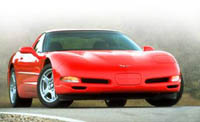 recognized
around the world as a true American icon. With the introduction of the
all-new Corvette in 1997, Chevrolet opted for a refinement of the
previous model rather than a radical departure from the classic,
successful Corvette formula. Refinement is the word used most often by
the automotive mediaóthe car's improved structural rigidity
and quality construction have drawn much praise.
Model years: 1988-96, 97-98 recognized
around the world as a true American icon. With the introduction of the
all-new Corvette in 1997, Chevrolet opted for a refinement of the
previous model rather than a radical departure from the classic,
successful Corvette formula. Refinement is the word used most often by
the automotive mediaóthe car's improved structural rigidity
and quality construction have drawn much praise.
Model years: 1988-96, 97-98
Trim Details: The 1999 Chevrolet
Corvette is available in three trims: Hardtop, Coupe and Convertible.
Safety features include dual airbags, an anti-lock brake system (ABS),
traction control and daytime running lights. Powering all Corvettes
is a 5.7-liter V8 engine that produces 345 horsepower. A 4-speed
automatic transmission is standard on the Coupe and Convertible,
with a 6-speed manual standard for the Hardtop. Standard features include
air conditioning, a rear window defroster, power door locks and windows,
a low tire pressure warning system, a theft-deterrent system, and
an AM/FM stereo cassette. Sport bucket seats, dual-zone climate control,
heads-up display and halogen fog lights are available options only
on the Coupe and Convertible. |